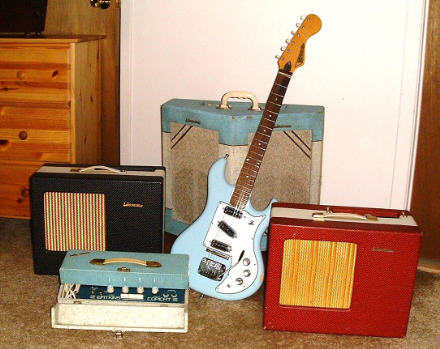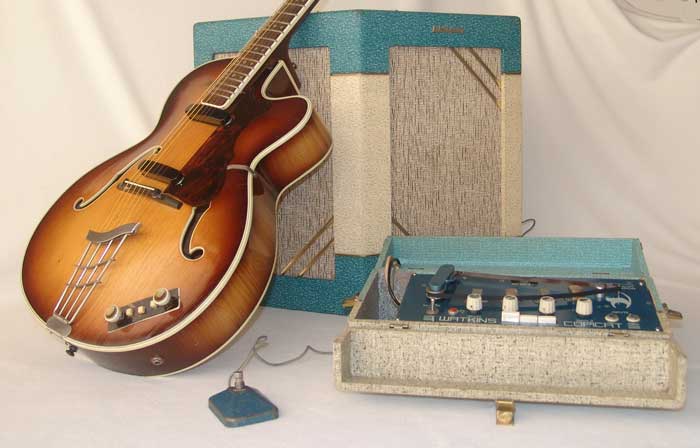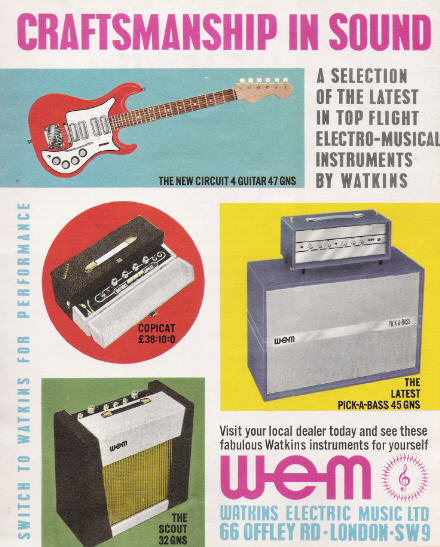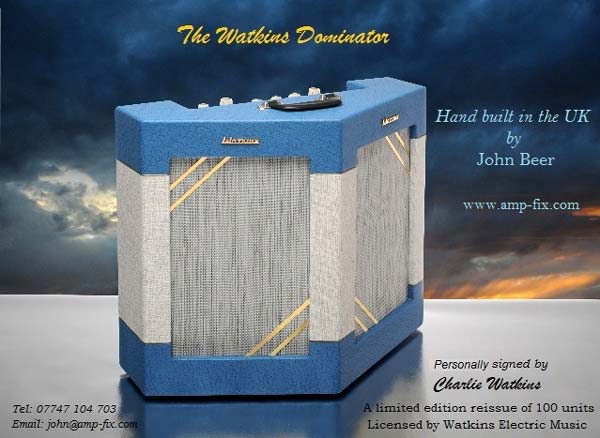WATKINS / WEM GUITAR AMPLIFIERS
- CHARLIE'S ANGELS !

Phil Avelli's Watkins Collection (New York, USA)


Phil Avelli's Watkins Collection (New York, USA)
There are other websites now which deal with Watkins/WEM gear, the most notable of which are Charlie Watkins' own site of course, Gordon Healy's WEM Owners Site, and Reg Goodwin's excellent Watkins Guitar World website. We therefore did not go too deeply into the history of the Watkins Electrical Music Ltd, as we had done on the Selmer site, because this is already well covered elsewhere. We also decided not to stray off too far into the realms of the WEM PA systems that were so famous in the late 1960's and 70's. We were both guitar players, and so concentrating only on instrument amps made sense. What this website therefore has attempted to do is to produce a record of the various guitar and bass amplifier models, their specifications, and their many variations throughout the period when Watkins/WEM were at the height of their fame.
As with the Selmer website, the philosophy that was adopted with this website was that we first concentrated on putting down our joint knowledge on the subject. This relied on us using memory going back nearly 40 years, together with old catalogue entries and magazine articles. Since then, Tim has bowed out and I have continued to expand the site using further information in the form of discovered catalogues, particularly from the famous mail-order company in the UK, Bell Musical Instruments, and of course Watkins/WEM marketing, Also used has been old Watkins adverts placed at the time in such publications as the Melody Maker, Beat Instrumental. and NME, together of course from the photos and memories kindly sent to me by many of the Watkins enthusiaists throughout the World.
The development of most models are, we hope, covered in their
specific descriptions, but some general notes may assist the visitor in identifying
and dating amps.
Little is known (to me so far, anyway) of the very early AC/DC Watkins amps
from the mid 1950s : they apparently had plain grey coverings, and according to
Manchester's Johnny Reno who encouraged Charlie in his venture they had a
"pre-war look about them". It seems that in 1957 the Westminster model was
introduced with the early Clubman and Dominator models morphing out of the
Westminster by around 1960. The early Watkins advertisements placed in "Melody Maker" have been used to
ascertain this date line.
The process of re-branding into Wem in 1963/64 seems to have been a gradual one. First
"day-glo" orange Wem logos replaced the brass Watkins logos, then
black & cream coverings appeared, and finally by 1964 the whole range was re-styled into plain black cabs with red/gold diamond pattern
grill-cloth, a cosmetic
appearance which lasted well into the 1970s.
THE WESTMINSTER (1957 to c1980) Most Versions Valve Powered
THE DOMINATOR (1960 to c1982) Valve Powered
THE CLUBMAN (c1960 to c1980) Most Versions Valve Powered
THE MONITOR (1962/63) Valve Powered
THE JOKER (1962 to 1964) Valve Powered
THE SCOUT& MERSEY SUPER 15 (1963 to 1964) Valve Powered
THE WARRIOR BASS (c1963/64) Valve Powered
THE CUSTOM 15 (1965 to 1967) Valve Powered
THE POWER CAT (1965 to 1967) Valve Powered
THE SAPPHIRE 60 (1967)
THE DEEP BLUE (1967 to 1968) Valve Powered
THE MUSETTE (ORGAN/ACCORDION) (1968 to 1978)
THE MONITOR REVERB 50 (1971 to 1974) Valve Powered
THE SAPPHIRE 100 (1978 to 1979) Solid State
(1963 to 1964) Valve Powered

My own c1963 Watkins Dominator Amp & c1961 Watkins Copicat, together with my 1959 Hofner President.

1963 WEM Advertisement, courtesy of Brian Watters, UK.

(.....as is now also the Clubman and Westminster!! )